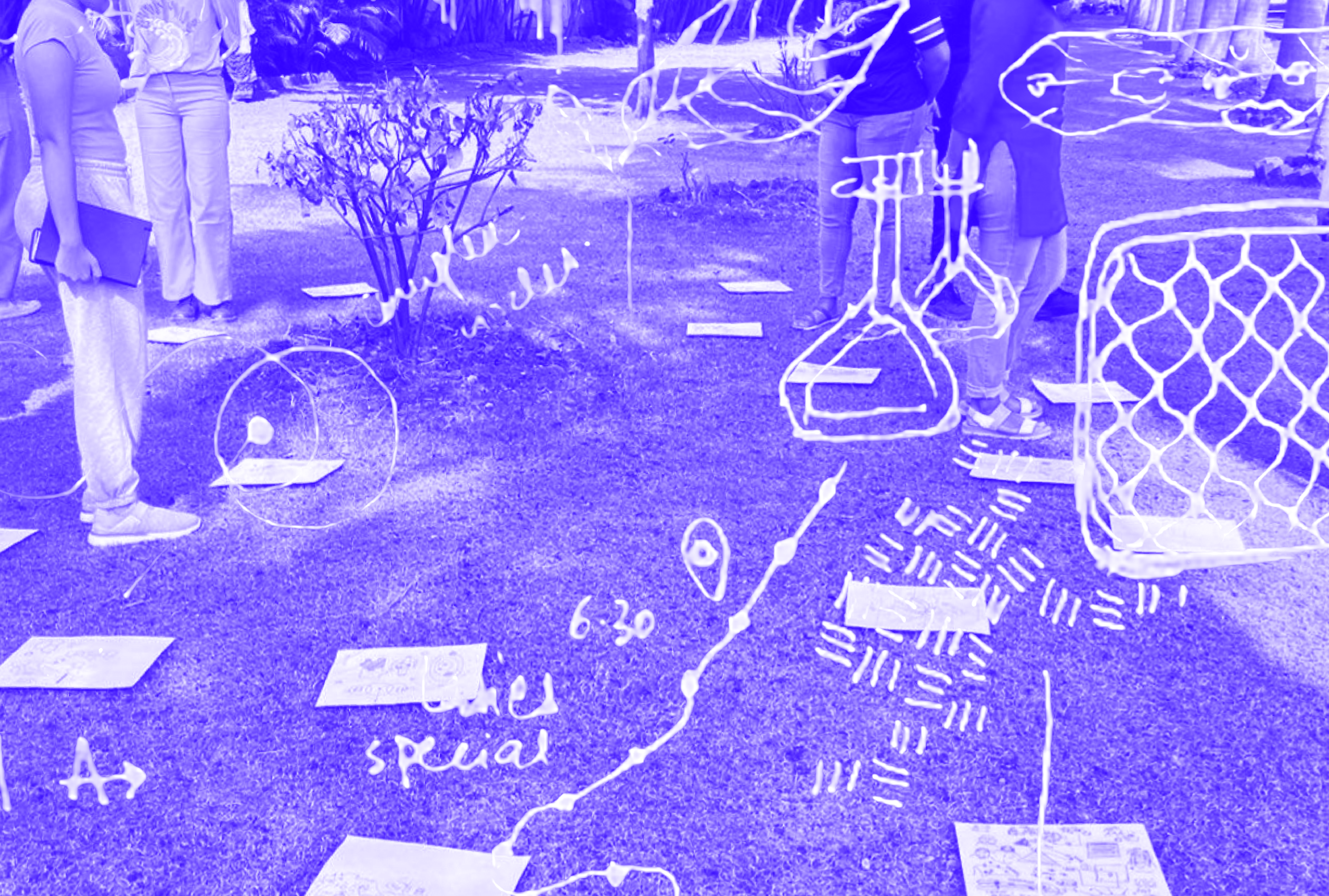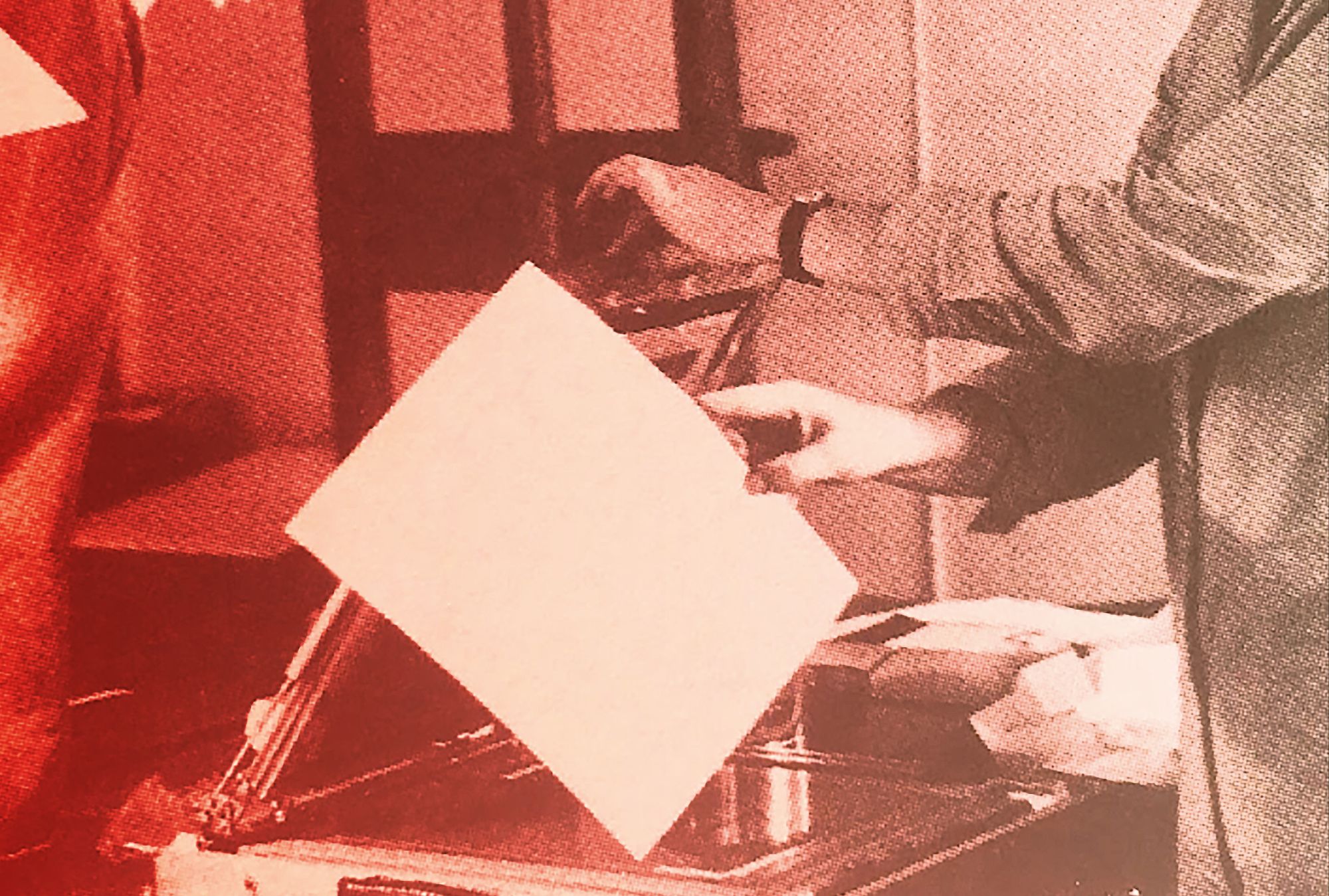
When Siri was released by Apple in 2011, one of the first things people did was try to piss off the new virtual assistant. There are tons of videos of users—mostly men—verbally abusing Siri, and even a wikihow titled “How to upset Siri.” But the thing is: Siri never actually gets angry or upset. Her reactions—and here, our choice of pronoun is intentional—are usually evasive, neutral or even coy. Like most AI voice assistants, Siri is feminized.
When asked to “go fuck [herself],” Siri originally replied: “I’d blush if I could,” causing particular outrage among feminists. Siri’s imaginary cheeks were coded to react like an embarrassed Victorian dame, projecting the image of female submissiveness. “I’d blush if I could” has since become the title of an extensive UNESCO report that pointed out the dangers of equipping Siri with personality traits that reinforce gender biases and perpetuate commonly held notions that women are subservient and tolerant of poor treatment.
In response, Apple has since got rid of that particular answer, and also introduced male voice options. If you now ask Siri about her gender, she claims to have none, and says: “I don’t have an answer for that” or “Animals and french nouns have genders. I do not.” But Siri’s name and default voice are still socially read as female. Despite the update, the voice assistant remains essentially a friendly, calm, kind of efficient, more or less smart and witty, diligent servant that never, ever gets angry.
“As pointed out by the UNESCO report, Siri and other feminized voice assistants like Amazon Echo/Alexa reinforce a culture that teaches people to equate women with assistants—and conversely, to penalize real women for not being assistant-like.”
As pointed out by the UNESCO report, Siri and other feminized voice assistants like Amazon Echo/Alexa reinforce a culture that teaches people to equate women with assistants—and conversely, to penalize real women for not being assistant-like. But there’s nothing new about this stereotype. In fact, the equation of women to assistants has been programmed into our social fabric over the last 100 years.
Feminizing Data-Processing
Let’s travel back to the end of the 19th century. This was a time of economic disruption in the West, powered by mechanization and automation. Mass labour was suddenly no longer restrained to factories, but expanded to the first Victorian offices, followed closely by the U.S.A. Ironically, this did not mean the days of manual labour were over. Skilled workers such as typists were in high demand to process the growing amount of data that came hand in hand with the new office culture and growing complexification of companies. Only, there was a catch: men were not interested in this line of work.

Women were invited to join the office to fill the positions that required a high degree of manual labour, with repetitive and monotonous steps. Historian Kenneth Lipartito described this time as “when women were switches,” and claims that the slow evolution of mechanization helped preserve patriarchal relations.
In his book The Computer Boys Take Over, the historian Nathan Emsenger pinpointed that the number of women employed as typists was at around 96,000 women in 1910, rising quickly to over a million by 1930. But this process of feminization was not a product of feminist activism claiming space for women in the labor force. Instead, it was the result of a very patriarchal and capitalist supply-and-demand logic. According to historian Donald Hoke, companies grew in size as well as complexity, and as a result, they had to hire a huge amount of clerks. At the same time, the typewriter was introduced to the day-to-day office operations. Notably, wages for female workers were considerably lower than for their male counterparts. Companies hired young women as typists for a lot cheaper—a pattern we still see repeating itself to this day.
“Wages for female workers were considerably lower than for their male counterparts. Companies hired young women as typists for a lot cheaper—a pattern we still see repeating itself to this day.”
Sociologist Judy Wajcman also speculates that the typewriter became socially constructed as female because images of piano play—an activity suitable for young ladies—were associated with typing. Conversely, feminist theorist Hilary Bergen claims that 1940s advertisements used underlying sexual undertones to connect women with typewriters.
But it was not only typing that was becoming gendered in this new professional world. In the early twentieth century, the telephone began to conquer offices, and with it came the new job of a switchboard operator. This meant plugging circuits and wires together to establish a telephone connection between callers. Telephone companies almost exclusively hired young, unmarried, white women for this job because the overwhelmingly white male managerial staff believed that women naturally possessed the necessary skills for operating switchboards. After all, was it not true that attention to detail, active listening, detail-oriented working—as well as a kind and obliging appearance—were inherent to women? A short-lived experiment with teenage boy switchboard operators showed that they neither had the discipline nor the desired communication skills to handle callers. Female operators, on the other hand, stayed calm even when confronted with grumpy or erratic clients. In 1900, according to Lipartito, 80% of all switchboard operators in the U.S.A. were female.
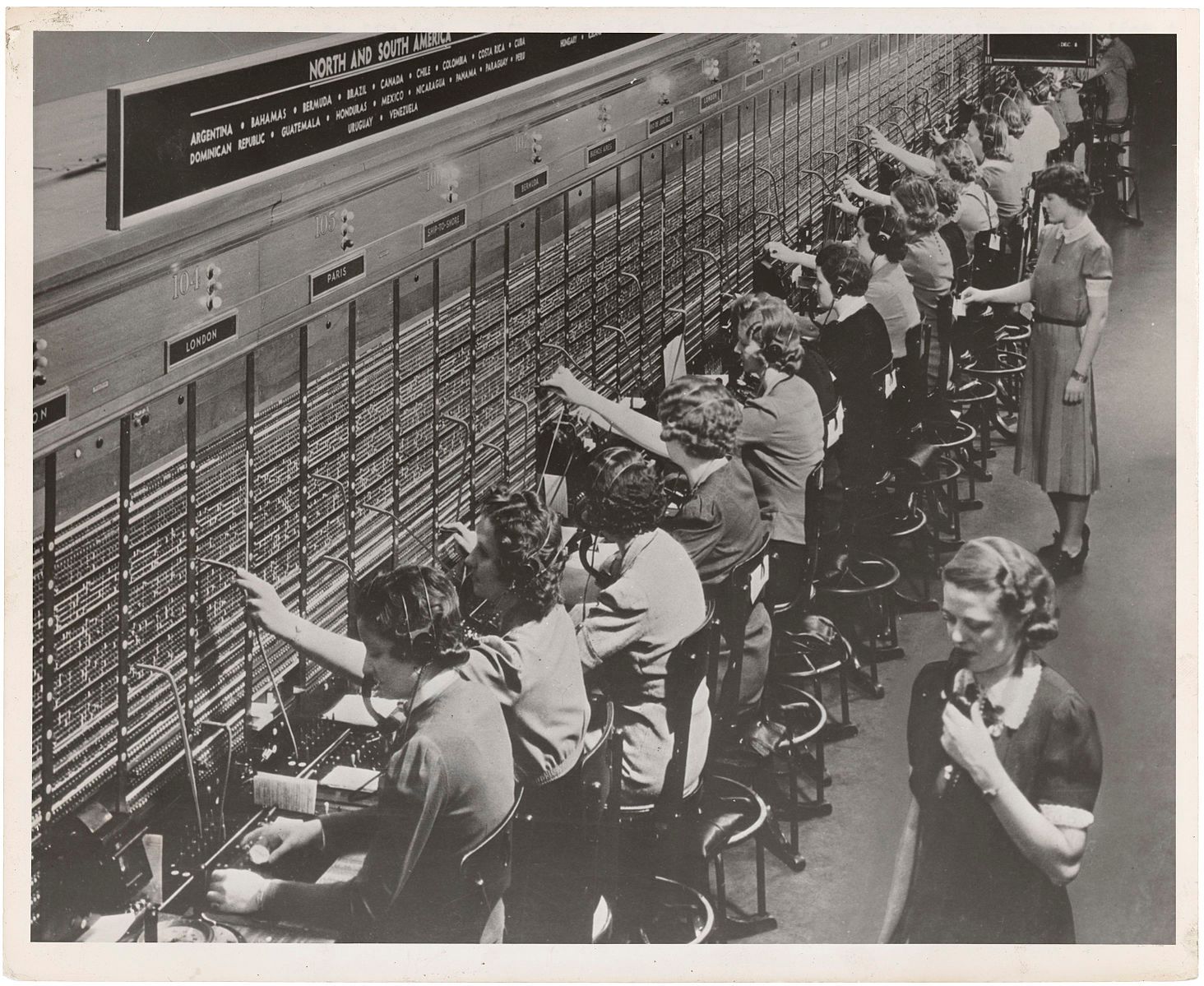
In this process, it was not just typing or taking calls that was becoming coded as female, but data-processing in general. The organizational change in offices at the turn of the century produced an avalanche of data in the form of memos, letters, forms, statements and bills. New technologies such as typewriters, telephones or telegrams helped to record and transmit this data on a new scale. According to history professor Sharon Hartman Strom, the number of hired clerks in the U.S.A. doubled between 1910-1930, despite the intense industrialization and mechanization. Historian Nathan Emsenger points out that, by the early 20th century, data-processing work had become almost entirely feminized, and the term “computer” was universally understood as referring to a “woman calculator.”
“As these jobs [such as switchboard operator or typist] got feminized, they also became low-level, dead-end jobs, locking women into separate job categories. Consequently, ‘women’s work,’ which was already underpaid, became also socially coded as ‘unskilled.’”
It is often believed that jobs like typist or switchboard operator were feminized because women had to be paid less than men. At least in the case for switchboard operators, this is not entirely true because starting salaries for men and women were around the same level; however, men had much better promotion prospects than women. Sure, women clerks were white-collar jobs, more respectable and better paid than factory work—but they had no prospect for promotion, and a dreary routine of repetitive manual labor that most men didn’t even consider as a line of work. In short: as these jobs got feminized, they also became low-level, dead-end jobs, locking women into separate job categories. Consequently, “women’s work,” which was already underpaid, became also socially coded as “unskilled.”
By the 1930s, the doors to low-level jobs in data-processing were wide open to white, unmarried women. But once married, these women were expected to quit paid work and take care of the home and family. There, they would come into contact with a new set of technologies: the electric household appliances, which would soon also become feminized.
The Electric Housewife
Also from the 19th century onwards, the feminization of technology began to enforce itself beyond the professional world. Savvy companies discovered the household as an untapped market for an array of new appliances which promised to free women from the burden of care work—a promise that, in hindsight, seems rather dubious.
The origin for this push for the household as a market was a truly remarkable invention: electricity. Public buildings were already illuminated by electric light as early as the end of the 19th century, and the number of households with electric light was steadily increasing. But there was a downside: natural daylight, which was free, was a rival electricity companies could not beat, making their supply only needed in early mornings and evenings. This is why, in a nutshell, companies like the German General Electricity Company (AEG) began producing the first electrical household appliances such as electric water kettles, clothes irons, curling tongs and stoves. In other words, they electrified the household to increase the demand for their basic product: light.
Period advertisements and commercials from the early 20th century that praised the vision of a fully automated household, in effect, bankrolled the idea of the “electric housewife.” Women were fed the image of a modern housewife who can comfortably manage all her duties with the press of a button. Gone were the times when housewives had to cook over an open hearth, or scrub the floors on their knees! Thanks to electricity, women now had an armada of little helpers that handled housework almost by themselves—at least, that seemed to be the narrative of advertisements of the time. A 1931 vacuum cleaner ad depicts an elegantly dressed woman who nonchalantly hoovers her home. Outside the windows, we see other women beating carpets by hand. The slogan reads “Lady, but also housewife” suggesting that being both was not possible till this date. But is that really what happened?
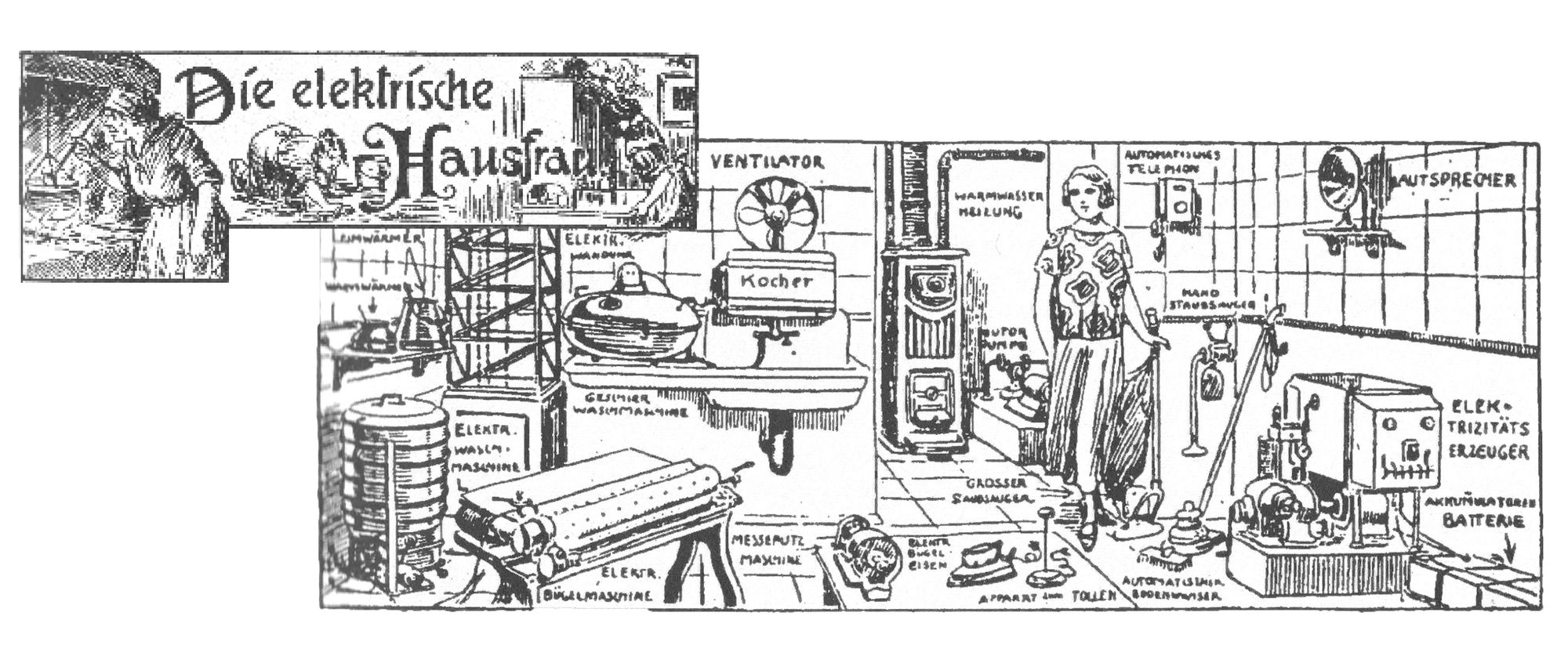
Instead of freeing women from the claws of arduous housework, electricity multiplied women’s labor. Sure, women did not have to scrub floors on their knees anymore, but now were expected to wash laundry whiter than white, not only once a week but on a daily basis. The electric household appliances raised standards for cleanliness, and operating a growing arsenal of household appliances became a time-consuming task in itself. Essentially, more appliances in the household did not equal less housework.
From Rosie to Roomba
The swinging ’60s saw a new vision of housework: what if the human housewife could be replaced by a robot? The animated television series The Jetsons (1963-1964) showed its audience a futuristic utopia of family life. The Jetson family—a counterpart to the prehistoric Flintstone family—lived in some distant future with foldable flying saucers, computers and cyborgs. Of course, the Jetsons owned their own robot: an anthropomorphized household android named Rosie, who cleans and maintains everything in the house, and prepares all the meals for the family.
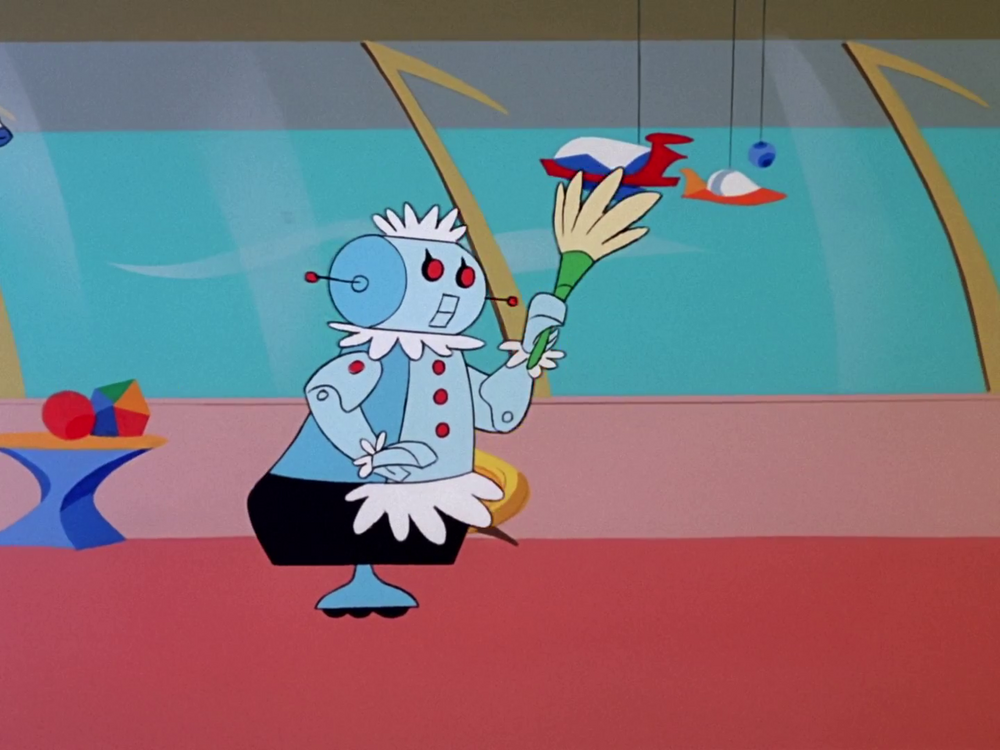
Dressed in a French maid outfit, Rosie perfectly represented the ideal of the benevolent but energetic middle-aged housekeeper. Her labor essentially allows for the mother, Jane Jetson, to maintain the façade of a domestic goddess. What is never discussed in the show is the fact that Rosie is performing the kind of work that, at that time, was almost exclusively reserved for poor people of color in the U.S.A., especially women. Like most television programs of the time, The Jetsons perpetuated damaging stereotypical depictions of class and race.
Another 50 years had to pass before Rosie became a reality and moved into households worldwide. To be exact, it was not the Rosie that the creators of The Jetsons envisioned, but Roomba, a vacuum-cleaning robot in the shape of a huge black disc. The electric housewife had finally gone digital! Roomba referenced Rosie in the form of a paste-on costume sticker, which transformed the sleek surface of vacuum-cleaning robots into a housekeeper’s iconic uniform. This way, under an allegedly ironic pretense, the stereotypical depiction of care work—which, even in the 1960s, represented a retro-futuristic version of domestic femaleness—was once more actualized.
Beyond Retro-Futuristic Visions
Roomba is not just a robot but a “smart wife”—a term coined by researchers Yolande Strengers and Jenny Kennedy in their book The Smart Wife: Why Siri, Alexa and Other Smart Home Devices Need a Feminist Reboot, to describe machines that assume traditionally female responsibilities without complaint. They explain: “[There is] a historical and ongoing preoccupation with outsourcing ‘women’s work’ (and racialized or undervalued labor) to an electronic, automated, and robotic workforce.”
“Whether it may be a friendly female voice on the phone, or the image of an attentive secretary on the typewriter, once these jobs were coded as female, they became self-fulfilling prophecies—just google ‘personal assistant’ and you’ll see.”
At a time when everyone seems to carry their personal switchboard operator in their pockets and so-called “smart wives” operate household appliances, this throwback feels more urgent than ever. As we saw, the feminization of clerical work created the stereotype of the female assistant, which was then reinforced by social interactions and the media. Whether it may be a friendly female voice on the phone, or the image of an attentive secretary on the typewriter, once these jobs were coded as female, they became self-fulfilling prophecies—just google “personal assistant” and you’ll see.
Feminized AI voices and personas like Siri are not a new problem; they are the reproduction of the same old clichés that have been programmed into our social fabric patriarchy. And of course, today’s tech industry is notoriously white and male. Worldwide, AI developers are 78% male, with Black employees representing only 2.5% of Google’s workforce and 4% of Facebook’s and Microsoft’s. Computer scientist and a leading AI researcher Timnit Gebru warns about the consequences of such hardwired bias in programming: “There’s a real danger of systematizing the discrimination we have in society [through AI technologies].”
“Do voice assistants need to be anthropomorphized at all? Could we imagine voice assistants that sound like minerals, animals or plants?”
This might all sound depressing, but those historical insights can also help us challenge prevailing standards in design and digital technologies, especially AI. For example, do voice assistants need to be anthropomorphized at all? Could we imagine voice assistants that sound like minerals, animals or plants? Recently, a team of computer scientists from London partnered with Feminist Internet to prototype a voice assistant centering trans and non-binary community. The result, Syb, points to real ways that an AI voice assistant could help protect one’s privacy, enforce the idea of consent, and foster joy.
So let’s not get stuck in visions of a retro-futuristic patriarchal technological utopia, but start developing our own expansive and imaginative visions of representation in AI. Let’s be critical of degrading and stereotypical images that creep into AI-powered technologies, adding another cycle to the old tune of discrimination. Let’s give space to perspectives that have been historically underrepresented, and build a better technological present, right now.
Amelie Goldfuß (she/her) is an artist, designer and educator navigating hybrid environments, robots, AI, technological weirdness and sociotechnical speculation. She uses post-/cross-disciplinary approaches to address topics like human-machine relationships or gender and technology.
Amelie co-founded Moving Target Collective, an interdisciplinary group investigating artificial intelligence by combining art, design, sociology and computer science. She is a lecturer at Burg Giebichenstein University of Art and Design in Halle.
Natalie Sontopski (she/her) studied Sociology, History and European Studies before founding Code Girls in 2012, a non-profit with the goal of offering free workshops and talks around the topic of code to girls and women. In 2016, she published her book We Love Code. The Little 101 of Programming. Since 2018, she has been employed as a research assistant at the Komplexlabor Digitale Kultur at Merseburg University of Applied Sciences, where she conducts research on how to convey complex technologies like AI to non-programmers. The focus of her work there lies on an techno-feminist approach to design sociology centered around AI.
She is also a founding member of Moving Target Collective.
This text was produced as part of the Troublemakers Class of 2020 workshop.
The title of this vertical, Epistemic Activism, is an homage to the disabled, nonbinary Iranian/SWANA designer and researcher Aimi Hamraie. In their book Building Access: Universal Design and the Politics of Disability, epistemic activism is described as a form of
political action that occurs within academic fields to shape social norms and practices.





